Impact of Green Marketing on Consumer Behaviour
VerifiedAdded on 2020/02/19
|14
|2863
|27
AI Summary
This assignment delves into the impact of green marketing practices on consumer behavior. It examines how factors like ethical claims, product labeling, and brand perception influence consumers' willingness to purchase eco-friendly products. The analysis draws upon relevant academic literature and research findings to understand the complex interplay between sustainability marketing and consumer choice.
Contribute Materials
Your contribution can guide someone’s learning journey. Share your
documents today.
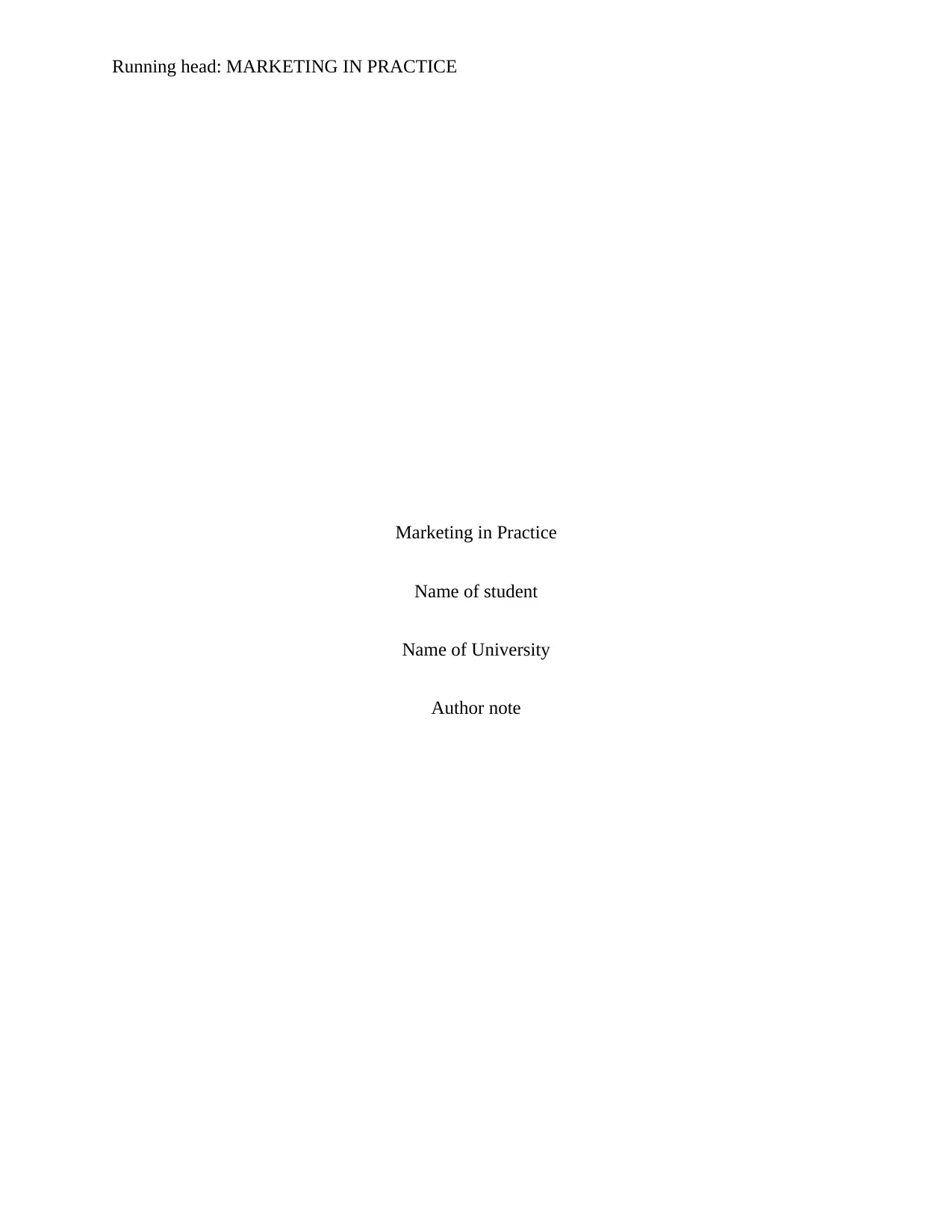
Running head: MARKETING IN PRACTICE
Marketing in Practice
Name of student
Name of University
Author note
Marketing in Practice
Name of student
Name of University
Author note
Secure Best Marks with AI Grader
Need help grading? Try our AI Grader for instant feedback on your assignments.
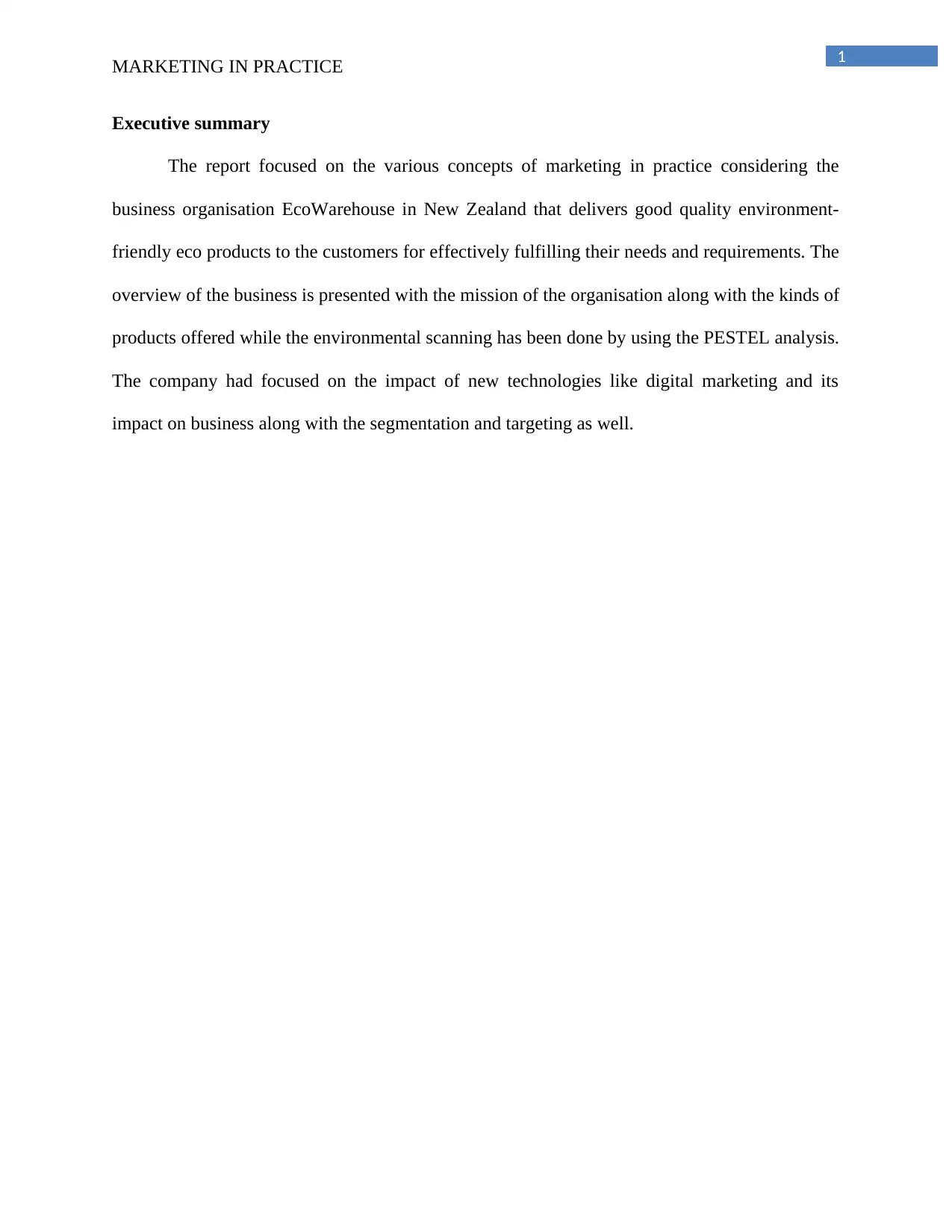
1
MARKETING IN PRACTICE
Executive summary
The report focused on the various concepts of marketing in practice considering the
business organisation EcoWarehouse in New Zealand that delivers good quality environment-
friendly eco products to the customers for effectively fulfilling their needs and requirements. The
overview of the business is presented with the mission of the organisation along with the kinds of
products offered while the environmental scanning has been done by using the PESTEL analysis.
The company had focused on the impact of new technologies like digital marketing and its
impact on business along with the segmentation and targeting as well.
MARKETING IN PRACTICE
Executive summary
The report focused on the various concepts of marketing in practice considering the
business organisation EcoWarehouse in New Zealand that delivers good quality environment-
friendly eco products to the customers for effectively fulfilling their needs and requirements. The
overview of the business is presented with the mission of the organisation along with the kinds of
products offered while the environmental scanning has been done by using the PESTEL analysis.
The company had focused on the impact of new technologies like digital marketing and its
impact on business along with the segmentation and targeting as well.
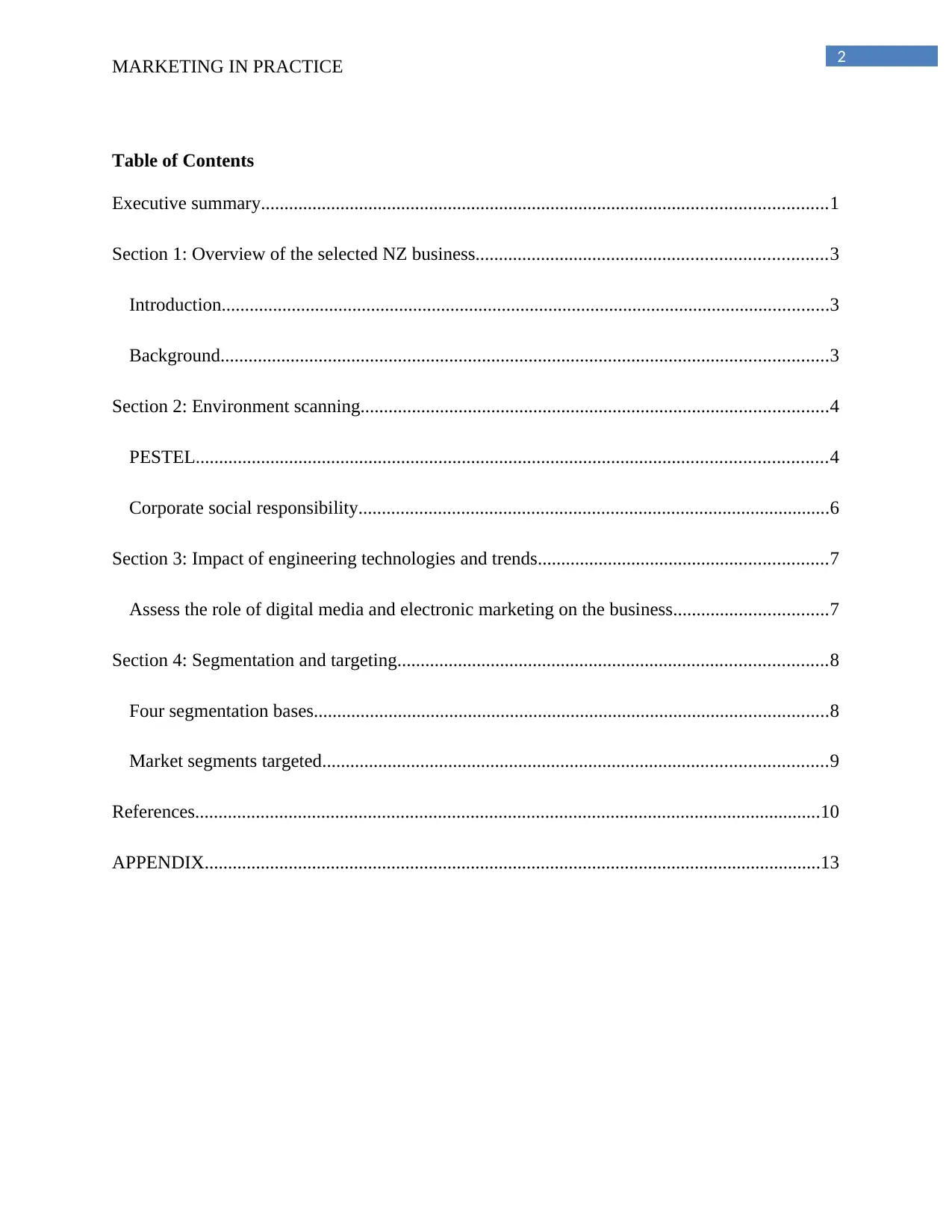
2
MARKETING IN PRACTICE
Table of Contents
Executive summary.........................................................................................................................1
Section 1: Overview of the selected NZ business...........................................................................3
Introduction..................................................................................................................................3
Background..................................................................................................................................3
Section 2: Environment scanning....................................................................................................4
PESTEL.......................................................................................................................................4
Corporate social responsibility.....................................................................................................6
Section 3: Impact of engineering technologies and trends..............................................................7
Assess the role of digital media and electronic marketing on the business.................................7
Section 4: Segmentation and targeting............................................................................................8
Four segmentation bases..............................................................................................................8
Market segments targeted............................................................................................................9
References......................................................................................................................................10
APPENDIX....................................................................................................................................13
MARKETING IN PRACTICE
Table of Contents
Executive summary.........................................................................................................................1
Section 1: Overview of the selected NZ business...........................................................................3
Introduction..................................................................................................................................3
Background..................................................................................................................................3
Section 2: Environment scanning....................................................................................................4
PESTEL.......................................................................................................................................4
Corporate social responsibility.....................................................................................................6
Section 3: Impact of engineering technologies and trends..............................................................7
Assess the role of digital media and electronic marketing on the business.................................7
Section 4: Segmentation and targeting............................................................................................8
Four segmentation bases..............................................................................................................8
Market segments targeted............................................................................................................9
References......................................................................................................................................10
APPENDIX....................................................................................................................................13
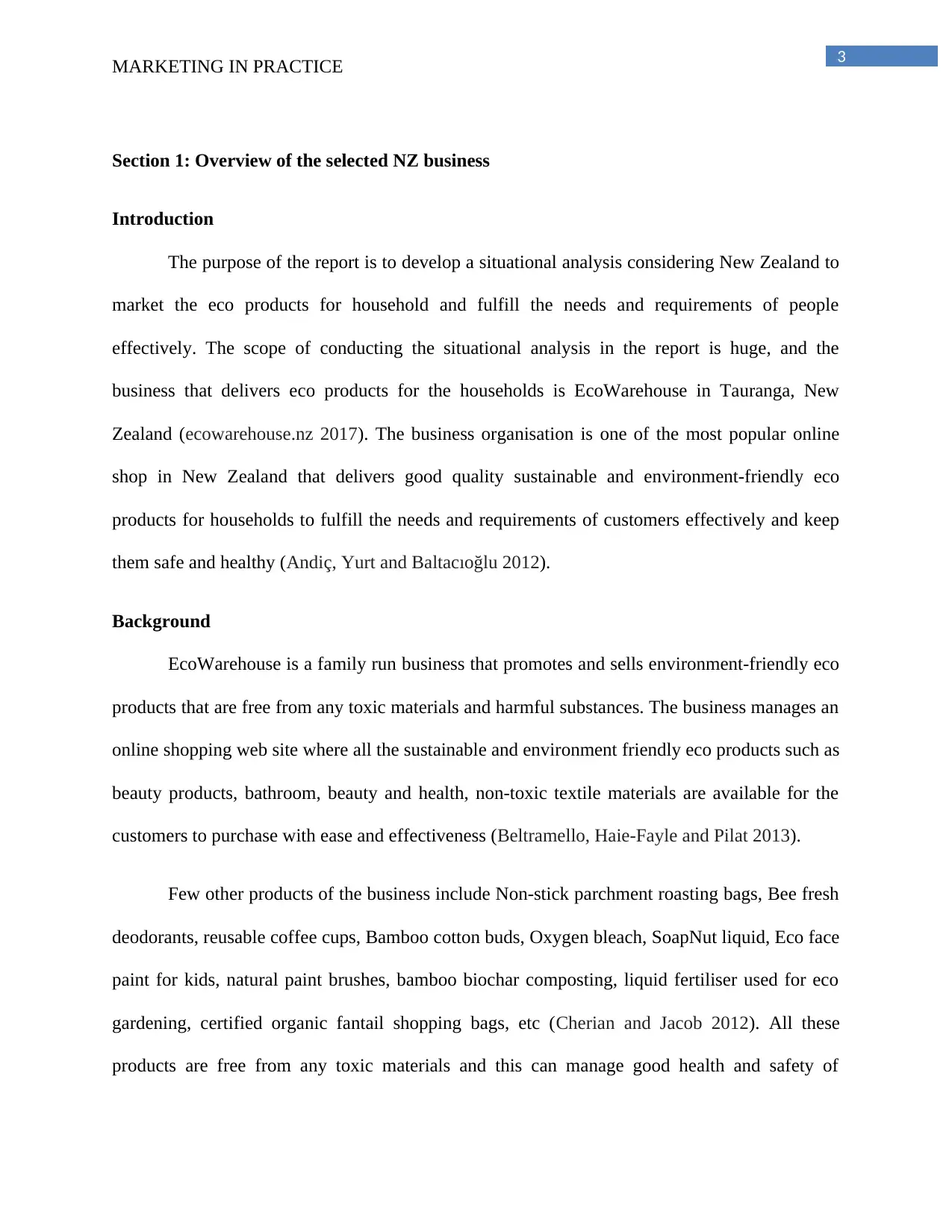
3
MARKETING IN PRACTICE
Section 1: Overview of the selected NZ business
Introduction
The purpose of the report is to develop a situational analysis considering New Zealand to
market the eco products for household and fulfill the needs and requirements of people
effectively. The scope of conducting the situational analysis in the report is huge, and the
business that delivers eco products for the households is EcoWarehouse in Tauranga, New
Zealand (ecowarehouse.nz 2017). The business organisation is one of the most popular online
shop in New Zealand that delivers good quality sustainable and environment-friendly eco
products for households to fulfill the needs and requirements of customers effectively and keep
them safe and healthy (Andiç, Yurt and Baltacıoğlu 2012).
Background
EcoWarehouse is a family run business that promotes and sells environment-friendly eco
products that are free from any toxic materials and harmful substances. The business manages an
online shopping web site where all the sustainable and environment friendly eco products such as
beauty products, bathroom, beauty and health, non-toxic textile materials are available for the
customers to purchase with ease and effectiveness (Beltramello, Haie-Fayle and Pilat 2013).
Few other products of the business include Non-stick parchment roasting bags, Bee fresh
deodorants, reusable coffee cups, Bamboo cotton buds, Oxygen bleach, SoapNut liquid, Eco face
paint for kids, natural paint brushes, bamboo biochar composting, liquid fertiliser used for eco
gardening, certified organic fantail shopping bags, etc (Cherian and Jacob 2012). All these
products are free from any toxic materials and this can manage good health and safety of
MARKETING IN PRACTICE
Section 1: Overview of the selected NZ business
Introduction
The purpose of the report is to develop a situational analysis considering New Zealand to
market the eco products for household and fulfill the needs and requirements of people
effectively. The scope of conducting the situational analysis in the report is huge, and the
business that delivers eco products for the households is EcoWarehouse in Tauranga, New
Zealand (ecowarehouse.nz 2017). The business organisation is one of the most popular online
shop in New Zealand that delivers good quality sustainable and environment-friendly eco
products for households to fulfill the needs and requirements of customers effectively and keep
them safe and healthy (Andiç, Yurt and Baltacıoğlu 2012).
Background
EcoWarehouse is a family run business that promotes and sells environment-friendly eco
products that are free from any toxic materials and harmful substances. The business manages an
online shopping web site where all the sustainable and environment friendly eco products such as
beauty products, bathroom, beauty and health, non-toxic textile materials are available for the
customers to purchase with ease and effectiveness (Beltramello, Haie-Fayle and Pilat 2013).
Few other products of the business include Non-stick parchment roasting bags, Bee fresh
deodorants, reusable coffee cups, Bamboo cotton buds, Oxygen bleach, SoapNut liquid, Eco face
paint for kids, natural paint brushes, bamboo biochar composting, liquid fertiliser used for eco
gardening, certified organic fantail shopping bags, etc (Cherian and Jacob 2012). All these
products are free from any toxic materials and this can manage good health and safety of
Secure Best Marks with AI Grader
Need help grading? Try our AI Grader for instant feedback on your assignments.
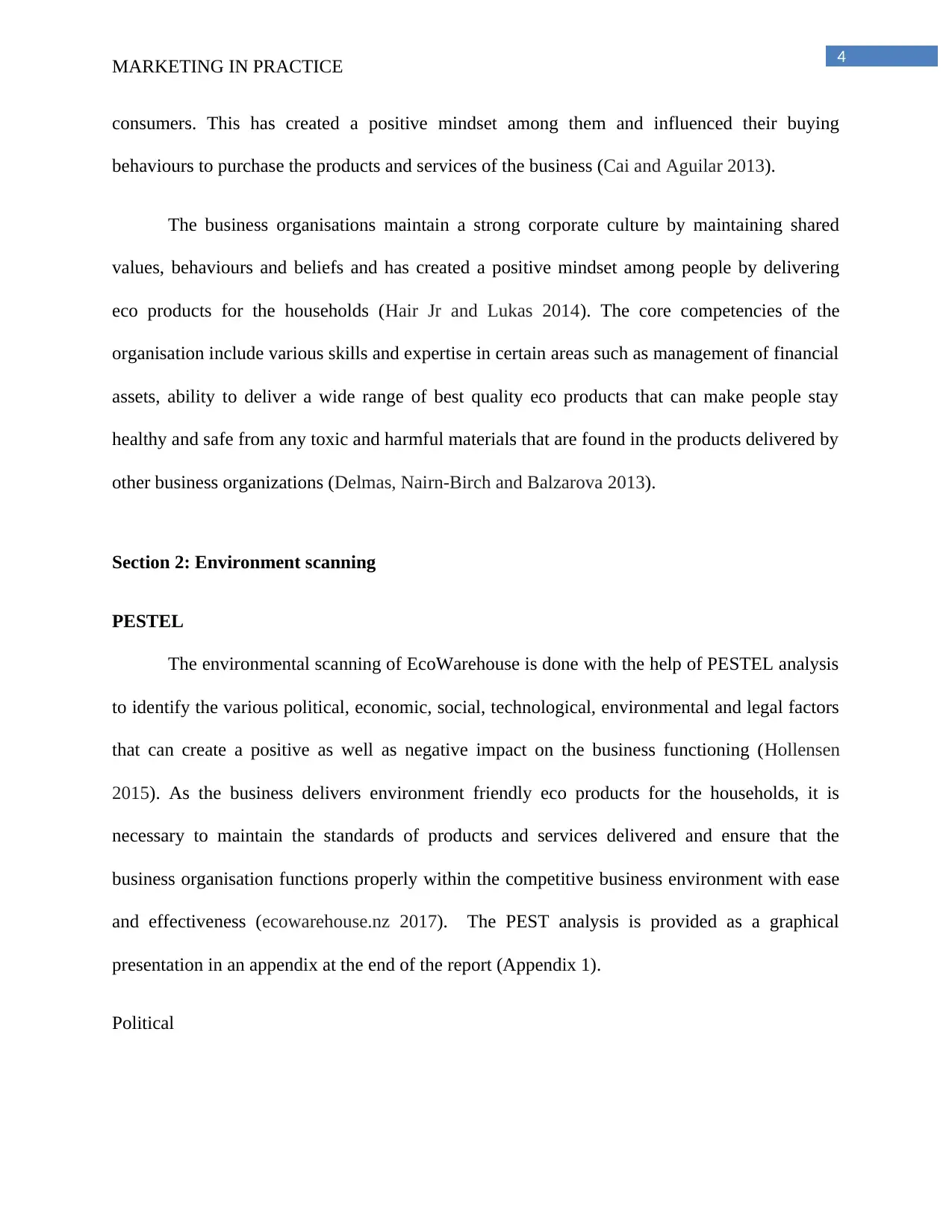
4
MARKETING IN PRACTICE
consumers. This has created a positive mindset among them and influenced their buying
behaviours to purchase the products and services of the business (Cai and Aguilar 2013).
The business organisations maintain a strong corporate culture by maintaining shared
values, behaviours and beliefs and has created a positive mindset among people by delivering
eco products for the households (Hair Jr and Lukas 2014). The core competencies of the
organisation include various skills and expertise in certain areas such as management of financial
assets, ability to deliver a wide range of best quality eco products that can make people stay
healthy and safe from any toxic and harmful materials that are found in the products delivered by
other business organizations (Delmas, Nairn-Birch and Balzarova 2013).
Section 2: Environment scanning
PESTEL
The environmental scanning of EcoWarehouse is done with the help of PESTEL analysis
to identify the various political, economic, social, technological, environmental and legal factors
that can create a positive as well as negative impact on the business functioning (Hollensen
2015). As the business delivers environment friendly eco products for the households, it is
necessary to maintain the standards of products and services delivered and ensure that the
business organisation functions properly within the competitive business environment with ease
and effectiveness (ecowarehouse.nz 2017). The PEST analysis is provided as a graphical
presentation in an appendix at the end of the report (Appendix 1).
Political
MARKETING IN PRACTICE
consumers. This has created a positive mindset among them and influenced their buying
behaviours to purchase the products and services of the business (Cai and Aguilar 2013).
The business organisations maintain a strong corporate culture by maintaining shared
values, behaviours and beliefs and has created a positive mindset among people by delivering
eco products for the households (Hair Jr and Lukas 2014). The core competencies of the
organisation include various skills and expertise in certain areas such as management of financial
assets, ability to deliver a wide range of best quality eco products that can make people stay
healthy and safe from any toxic and harmful materials that are found in the products delivered by
other business organizations (Delmas, Nairn-Birch and Balzarova 2013).
Section 2: Environment scanning
PESTEL
The environmental scanning of EcoWarehouse is done with the help of PESTEL analysis
to identify the various political, economic, social, technological, environmental and legal factors
that can create a positive as well as negative impact on the business functioning (Hollensen
2015). As the business delivers environment friendly eco products for the households, it is
necessary to maintain the standards of products and services delivered and ensure that the
business organisation functions properly within the competitive business environment with ease
and effectiveness (ecowarehouse.nz 2017). The PEST analysis is provided as a graphical
presentation in an appendix at the end of the report (Appendix 1).
Political
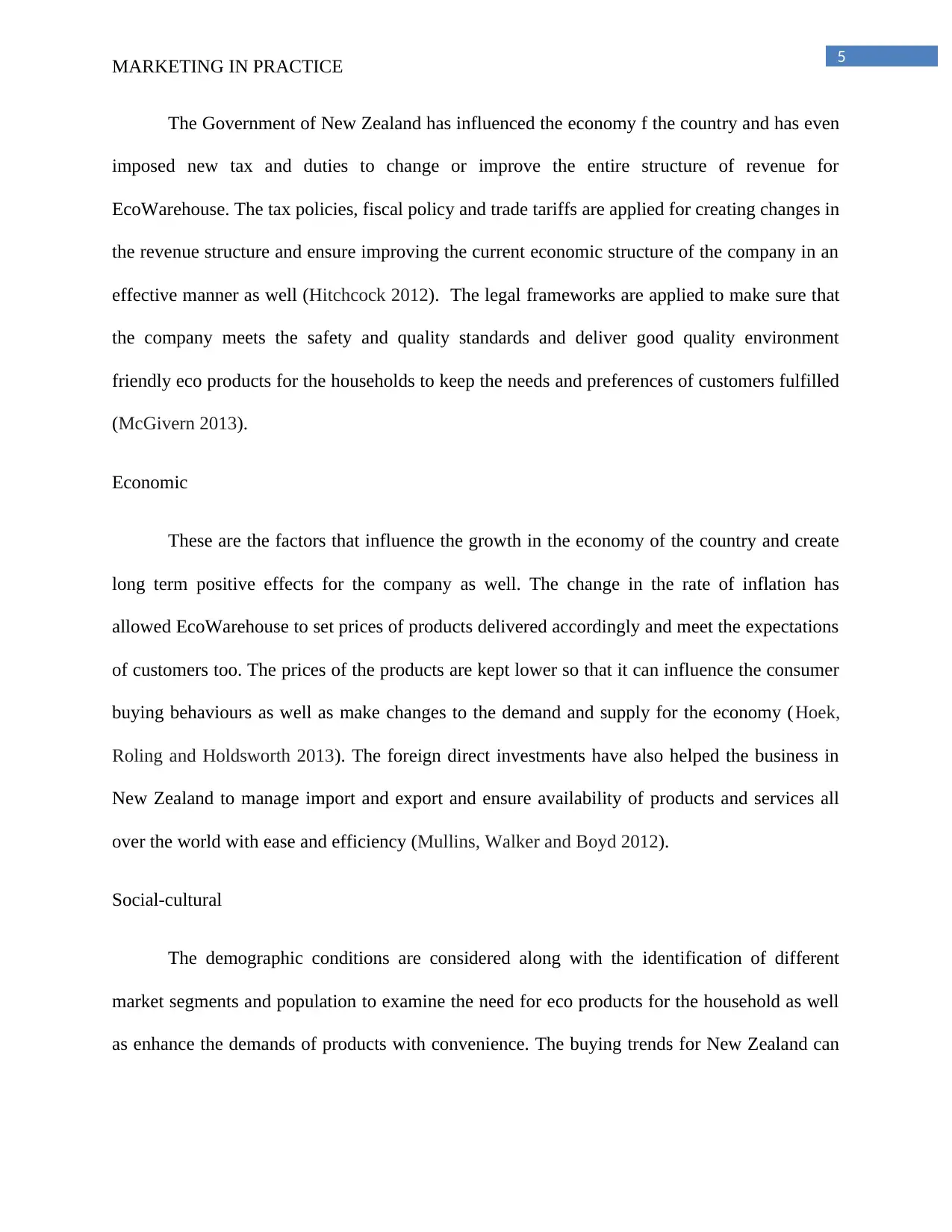
5
MARKETING IN PRACTICE
The Government of New Zealand has influenced the economy f the country and has even
imposed new tax and duties to change or improve the entire structure of revenue for
EcoWarehouse. The tax policies, fiscal policy and trade tariffs are applied for creating changes in
the revenue structure and ensure improving the current economic structure of the company in an
effective manner as well (Hitchcock 2012). The legal frameworks are applied to make sure that
the company meets the safety and quality standards and deliver good quality environment
friendly eco products for the households to keep the needs and preferences of customers fulfilled
(McGivern 2013).
Economic
These are the factors that influence the growth in the economy of the country and create
long term positive effects for the company as well. The change in the rate of inflation has
allowed EcoWarehouse to set prices of products delivered accordingly and meet the expectations
of customers too. The prices of the products are kept lower so that it can influence the consumer
buying behaviours as well as make changes to the demand and supply for the economy (Hoek,
Roling and Holdsworth 2013). The foreign direct investments have also helped the business in
New Zealand to manage import and export and ensure availability of products and services all
over the world with ease and efficiency (Mullins, Walker and Boyd 2012).
Social-cultural
The demographic conditions are considered along with the identification of different
market segments and population to examine the need for eco products for the household as well
as enhance the demands of products with convenience. The buying trends for New Zealand can
MARKETING IN PRACTICE
The Government of New Zealand has influenced the economy f the country and has even
imposed new tax and duties to change or improve the entire structure of revenue for
EcoWarehouse. The tax policies, fiscal policy and trade tariffs are applied for creating changes in
the revenue structure and ensure improving the current economic structure of the company in an
effective manner as well (Hitchcock 2012). The legal frameworks are applied to make sure that
the company meets the safety and quality standards and deliver good quality environment
friendly eco products for the households to keep the needs and preferences of customers fulfilled
(McGivern 2013).
Economic
These are the factors that influence the growth in the economy of the country and create
long term positive effects for the company as well. The change in the rate of inflation has
allowed EcoWarehouse to set prices of products delivered accordingly and meet the expectations
of customers too. The prices of the products are kept lower so that it can influence the consumer
buying behaviours as well as make changes to the demand and supply for the economy (Hoek,
Roling and Holdsworth 2013). The foreign direct investments have also helped the business in
New Zealand to manage import and export and ensure availability of products and services all
over the world with ease and efficiency (Mullins, Walker and Boyd 2012).
Social-cultural
The demographic conditions are considered along with the identification of different
market segments and population to examine the need for eco products for the household as well
as enhance the demands of products with convenience. The buying trends for New Zealand can
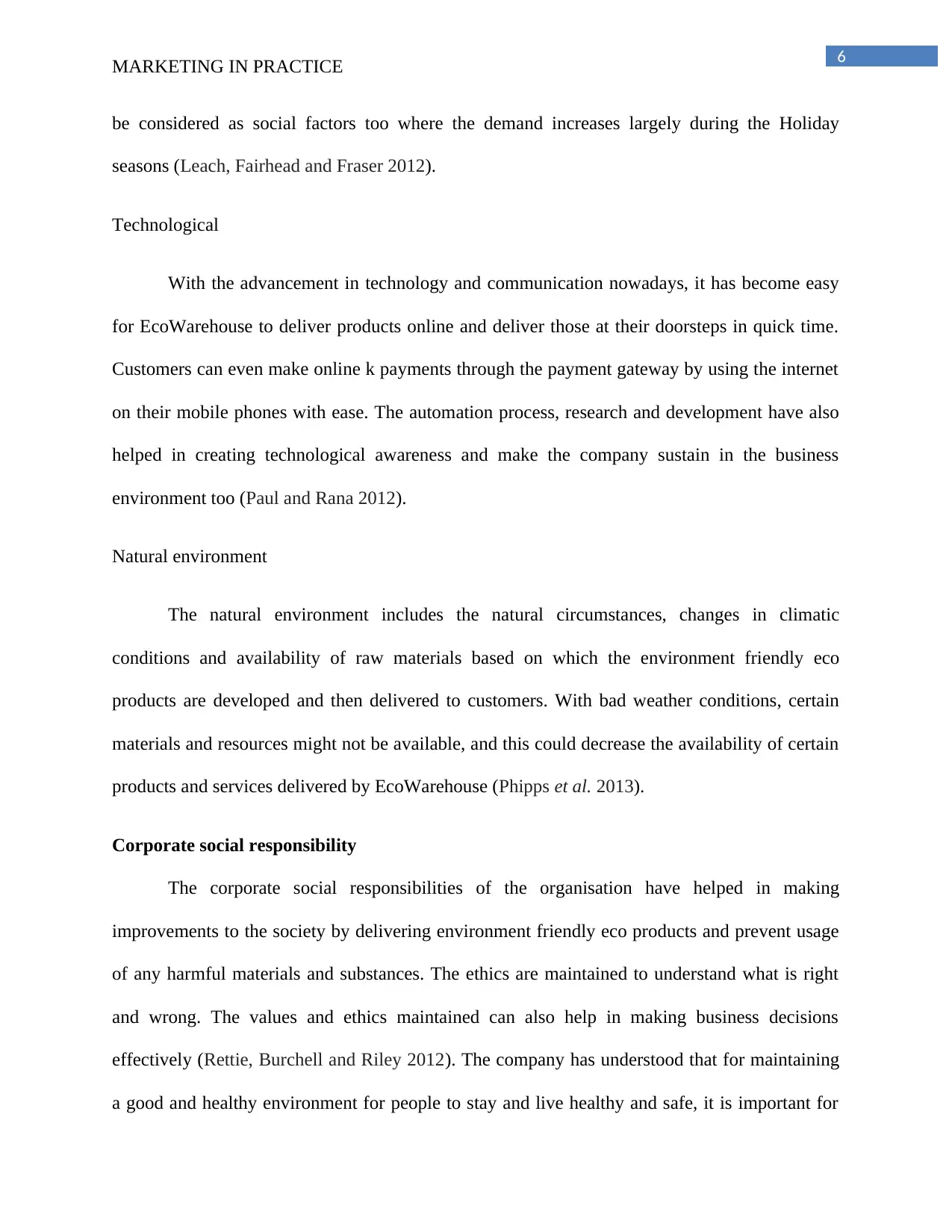
6
MARKETING IN PRACTICE
be considered as social factors too where the demand increases largely during the Holiday
seasons (Leach, Fairhead and Fraser 2012).
Technological
With the advancement in technology and communication nowadays, it has become easy
for EcoWarehouse to deliver products online and deliver those at their doorsteps in quick time.
Customers can even make online k payments through the payment gateway by using the internet
on their mobile phones with ease. The automation process, research and development have also
helped in creating technological awareness and make the company sustain in the business
environment too (Paul and Rana 2012).
Natural environment
The natural environment includes the natural circumstances, changes in climatic
conditions and availability of raw materials based on which the environment friendly eco
products are developed and then delivered to customers. With bad weather conditions, certain
materials and resources might not be available, and this could decrease the availability of certain
products and services delivered by EcoWarehouse (Phipps et al. 2013).
Corporate social responsibility
The corporate social responsibilities of the organisation have helped in making
improvements to the society by delivering environment friendly eco products and prevent usage
of any harmful materials and substances. The ethics are maintained to understand what is right
and wrong. The values and ethics maintained can also help in making business decisions
effectively (Rettie, Burchell and Riley 2012). The company has understood that for maintaining
a good and healthy environment for people to stay and live healthy and safe, it is important for
MARKETING IN PRACTICE
be considered as social factors too where the demand increases largely during the Holiday
seasons (Leach, Fairhead and Fraser 2012).
Technological
With the advancement in technology and communication nowadays, it has become easy
for EcoWarehouse to deliver products online and deliver those at their doorsteps in quick time.
Customers can even make online k payments through the payment gateway by using the internet
on their mobile phones with ease. The automation process, research and development have also
helped in creating technological awareness and make the company sustain in the business
environment too (Paul and Rana 2012).
Natural environment
The natural environment includes the natural circumstances, changes in climatic
conditions and availability of raw materials based on which the environment friendly eco
products are developed and then delivered to customers. With bad weather conditions, certain
materials and resources might not be available, and this could decrease the availability of certain
products and services delivered by EcoWarehouse (Phipps et al. 2013).
Corporate social responsibility
The corporate social responsibilities of the organisation have helped in making
improvements to the society by delivering environment friendly eco products and prevent usage
of any harmful materials and substances. The ethics are maintained to understand what is right
and wrong. The values and ethics maintained can also help in making business decisions
effectively (Rettie, Burchell and Riley 2012). The company has understood that for maintaining
a good and healthy environment for people to stay and live healthy and safe, it is important for
Paraphrase This Document
Need a fresh take? Get an instant paraphrase of this document with our AI Paraphraser
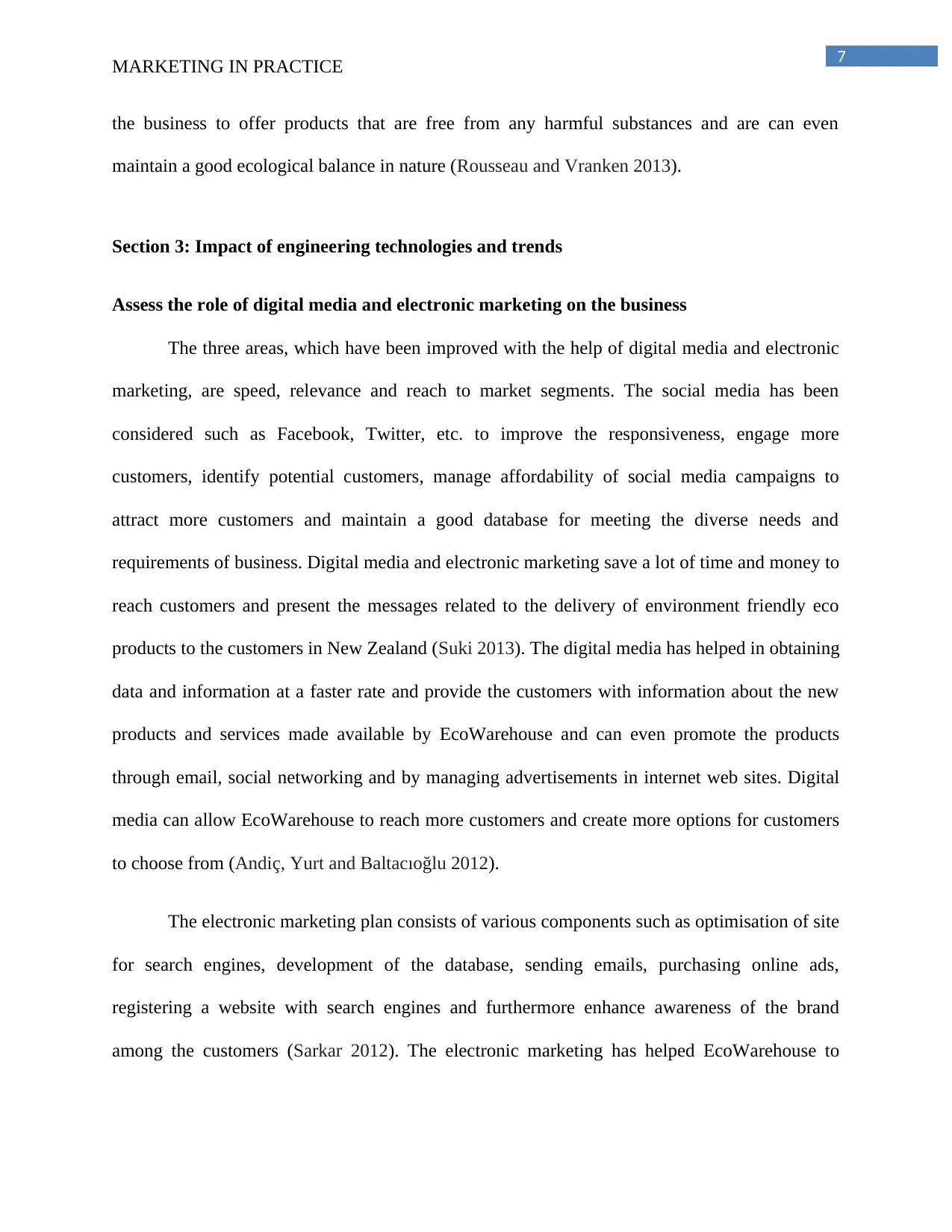
7
MARKETING IN PRACTICE
the business to offer products that are free from any harmful substances and are can even
maintain a good ecological balance in nature (Rousseau and Vranken 2013).
Section 3: Impact of engineering technologies and trends
Assess the role of digital media and electronic marketing on the business
The three areas, which have been improved with the help of digital media and electronic
marketing, are speed, relevance and reach to market segments. The social media has been
considered such as Facebook, Twitter, etc. to improve the responsiveness, engage more
customers, identify potential customers, manage affordability of social media campaigns to
attract more customers and maintain a good database for meeting the diverse needs and
requirements of business. Digital media and electronic marketing save a lot of time and money to
reach customers and present the messages related to the delivery of environment friendly eco
products to the customers in New Zealand (Suki 2013). The digital media has helped in obtaining
data and information at a faster rate and provide the customers with information about the new
products and services made available by EcoWarehouse and can even promote the products
through email, social networking and by managing advertisements in internet web sites. Digital
media can allow EcoWarehouse to reach more customers and create more options for customers
to choose from (Andiç, Yurt and Baltacıoğlu 2012).
The electronic marketing plan consists of various components such as optimisation of site
for search engines, development of the database, sending emails, purchasing online ads,
registering a website with search engines and furthermore enhance awareness of the brand
among the customers (Sarkar 2012). The electronic marketing has helped EcoWarehouse to
MARKETING IN PRACTICE
the business to offer products that are free from any harmful substances and are can even
maintain a good ecological balance in nature (Rousseau and Vranken 2013).
Section 3: Impact of engineering technologies and trends
Assess the role of digital media and electronic marketing on the business
The three areas, which have been improved with the help of digital media and electronic
marketing, are speed, relevance and reach to market segments. The social media has been
considered such as Facebook, Twitter, etc. to improve the responsiveness, engage more
customers, identify potential customers, manage affordability of social media campaigns to
attract more customers and maintain a good database for meeting the diverse needs and
requirements of business. Digital media and electronic marketing save a lot of time and money to
reach customers and present the messages related to the delivery of environment friendly eco
products to the customers in New Zealand (Suki 2013). The digital media has helped in obtaining
data and information at a faster rate and provide the customers with information about the new
products and services made available by EcoWarehouse and can even promote the products
through email, social networking and by managing advertisements in internet web sites. Digital
media can allow EcoWarehouse to reach more customers and create more options for customers
to choose from (Andiç, Yurt and Baltacıoğlu 2012).
The electronic marketing plan consists of various components such as optimisation of site
for search engines, development of the database, sending emails, purchasing online ads,
registering a website with search engines and furthermore enhance awareness of the brand
among the customers (Sarkar 2012). The electronic marketing has helped EcoWarehouse to
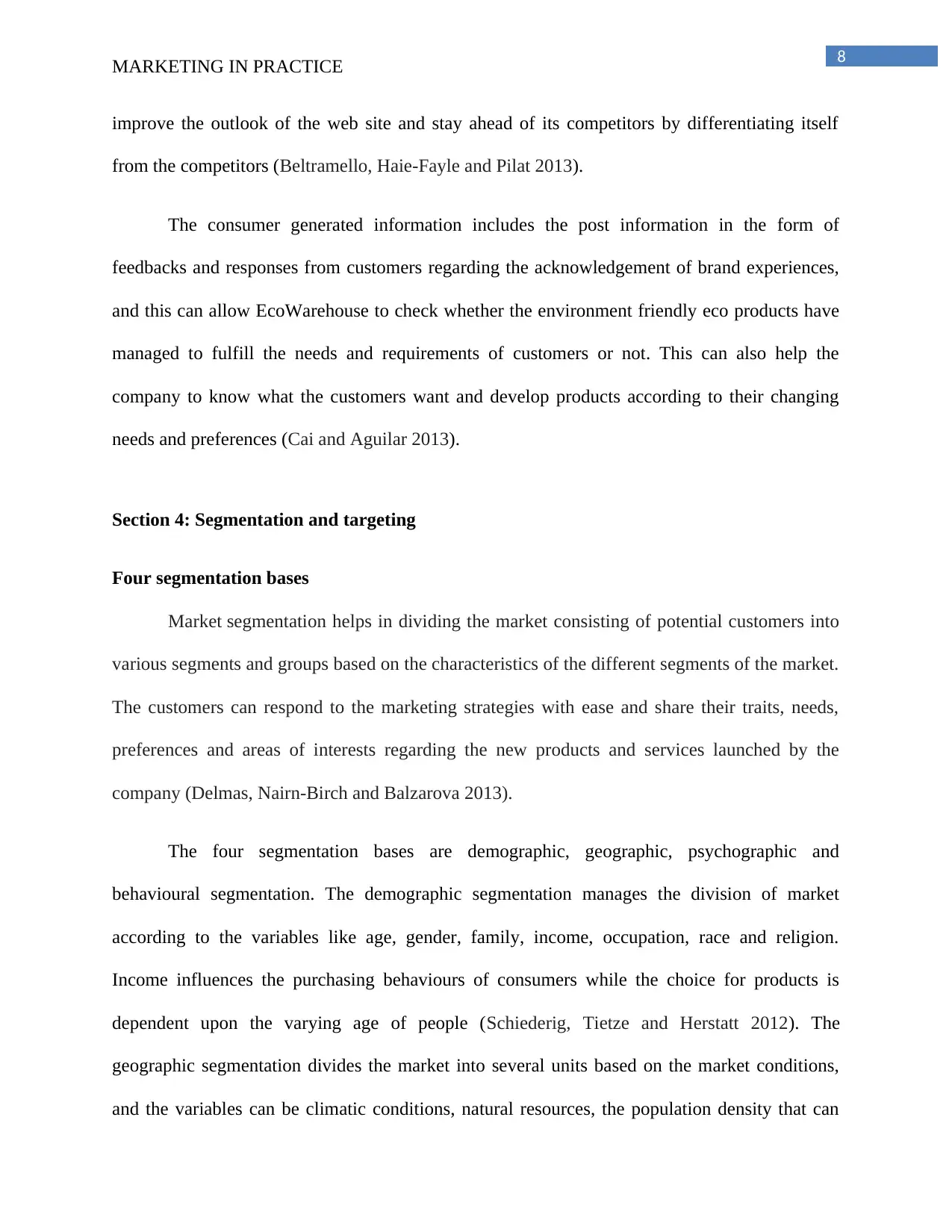
8
MARKETING IN PRACTICE
improve the outlook of the web site and stay ahead of its competitors by differentiating itself
from the competitors (Beltramello, Haie-Fayle and Pilat 2013).
The consumer generated information includes the post information in the form of
feedbacks and responses from customers regarding the acknowledgement of brand experiences,
and this can allow EcoWarehouse to check whether the environment friendly eco products have
managed to fulfill the needs and requirements of customers or not. This can also help the
company to know what the customers want and develop products according to their changing
needs and preferences (Cai and Aguilar 2013).
Section 4: Segmentation and targeting
Four segmentation bases
Market segmentation helps in dividing the market consisting of potential customers into
various segments and groups based on the characteristics of the different segments of the market.
The customers can respond to the marketing strategies with ease and share their traits, needs,
preferences and areas of interests regarding the new products and services launched by the
company (Delmas, Nairn-Birch and Balzarova 2013).
The four segmentation bases are demographic, geographic, psychographic and
behavioural segmentation. The demographic segmentation manages the division of market
according to the variables like age, gender, family, income, occupation, race and religion.
Income influences the purchasing behaviours of consumers while the choice for products is
dependent upon the varying age of people (Schiederig, Tietze and Herstatt 2012). The
geographic segmentation divides the market into several units based on the market conditions,
and the variables can be climatic conditions, natural resources, the population density that can
MARKETING IN PRACTICE
improve the outlook of the web site and stay ahead of its competitors by differentiating itself
from the competitors (Beltramello, Haie-Fayle and Pilat 2013).
The consumer generated information includes the post information in the form of
feedbacks and responses from customers regarding the acknowledgement of brand experiences,
and this can allow EcoWarehouse to check whether the environment friendly eco products have
managed to fulfill the needs and requirements of customers or not. This can also help the
company to know what the customers want and develop products according to their changing
needs and preferences (Cai and Aguilar 2013).
Section 4: Segmentation and targeting
Four segmentation bases
Market segmentation helps in dividing the market consisting of potential customers into
various segments and groups based on the characteristics of the different segments of the market.
The customers can respond to the marketing strategies with ease and share their traits, needs,
preferences and areas of interests regarding the new products and services launched by the
company (Delmas, Nairn-Birch and Balzarova 2013).
The four segmentation bases are demographic, geographic, psychographic and
behavioural segmentation. The demographic segmentation manages the division of market
according to the variables like age, gender, family, income, occupation, race and religion.
Income influences the purchasing behaviours of consumers while the choice for products is
dependent upon the varying age of people (Schiederig, Tietze and Herstatt 2012). The
geographic segmentation divides the market into several units based on the market conditions,
and the variables can be climatic conditions, natural resources, the population density that can
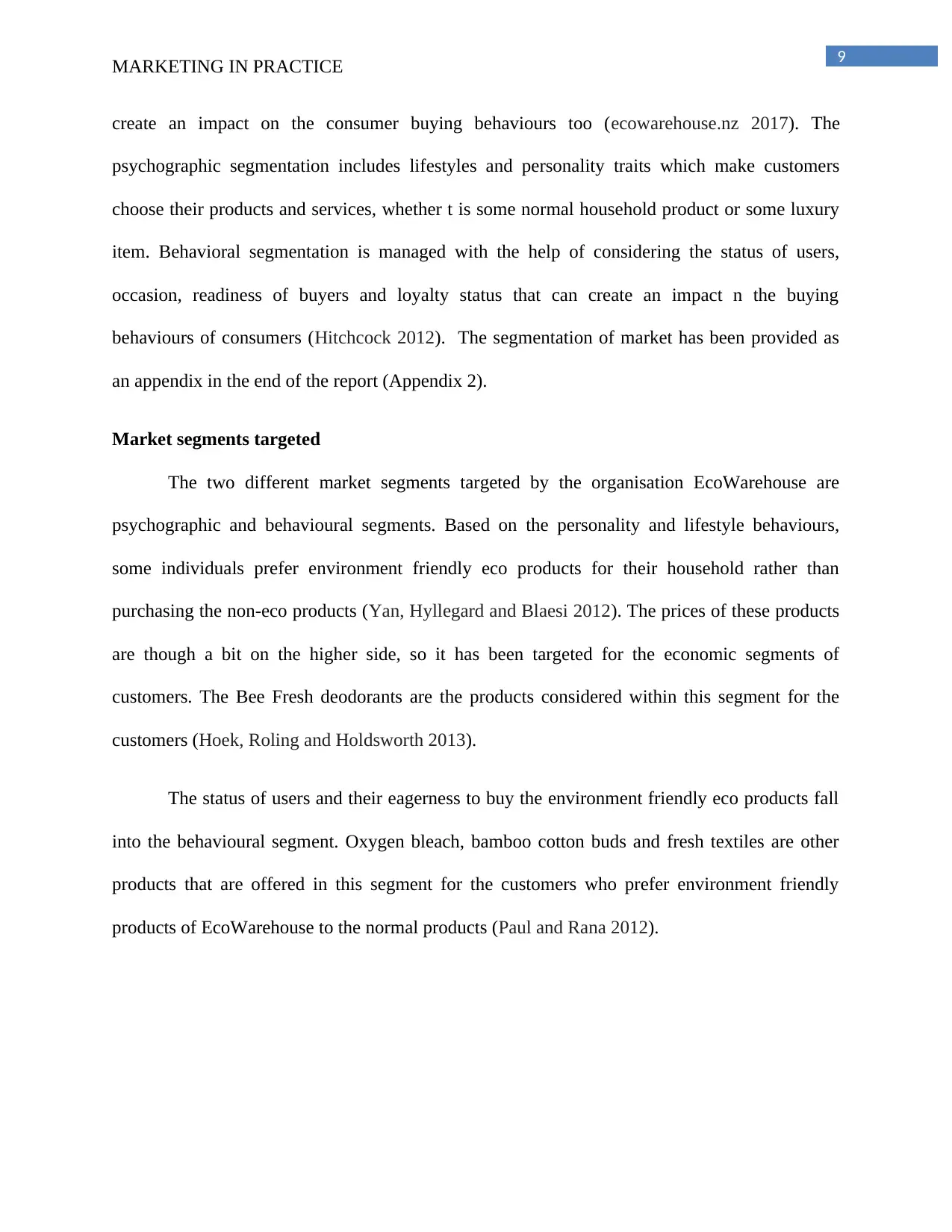
9
MARKETING IN PRACTICE
create an impact on the consumer buying behaviours too (ecowarehouse.nz 2017). The
psychographic segmentation includes lifestyles and personality traits which make customers
choose their products and services, whether t is some normal household product or some luxury
item. Behavioral segmentation is managed with the help of considering the status of users,
occasion, readiness of buyers and loyalty status that can create an impact n the buying
behaviours of consumers (Hitchcock 2012). The segmentation of market has been provided as
an appendix in the end of the report (Appendix 2).
Market segments targeted
The two different market segments targeted by the organisation EcoWarehouse are
psychographic and behavioural segments. Based on the personality and lifestyle behaviours,
some individuals prefer environment friendly eco products for their household rather than
purchasing the non-eco products (Yan, Hyllegard and Blaesi 2012). The prices of these products
are though a bit on the higher side, so it has been targeted for the economic segments of
customers. The Bee Fresh deodorants are the products considered within this segment for the
customers (Hoek, Roling and Holdsworth 2013).
The status of users and their eagerness to buy the environment friendly eco products fall
into the behavioural segment. Oxygen bleach, bamboo cotton buds and fresh textiles are other
products that are offered in this segment for the customers who prefer environment friendly
products of EcoWarehouse to the normal products (Paul and Rana 2012).
MARKETING IN PRACTICE
create an impact on the consumer buying behaviours too (ecowarehouse.nz 2017). The
psychographic segmentation includes lifestyles and personality traits which make customers
choose their products and services, whether t is some normal household product or some luxury
item. Behavioral segmentation is managed with the help of considering the status of users,
occasion, readiness of buyers and loyalty status that can create an impact n the buying
behaviours of consumers (Hitchcock 2012). The segmentation of market has been provided as
an appendix in the end of the report (Appendix 2).
Market segments targeted
The two different market segments targeted by the organisation EcoWarehouse are
psychographic and behavioural segments. Based on the personality and lifestyle behaviours,
some individuals prefer environment friendly eco products for their household rather than
purchasing the non-eco products (Yan, Hyllegard and Blaesi 2012). The prices of these products
are though a bit on the higher side, so it has been targeted for the economic segments of
customers. The Bee Fresh deodorants are the products considered within this segment for the
customers (Hoek, Roling and Holdsworth 2013).
The status of users and their eagerness to buy the environment friendly eco products fall
into the behavioural segment. Oxygen bleach, bamboo cotton buds and fresh textiles are other
products that are offered in this segment for the customers who prefer environment friendly
products of EcoWarehouse to the normal products (Paul and Rana 2012).
Secure Best Marks with AI Grader
Need help grading? Try our AI Grader for instant feedback on your assignments.
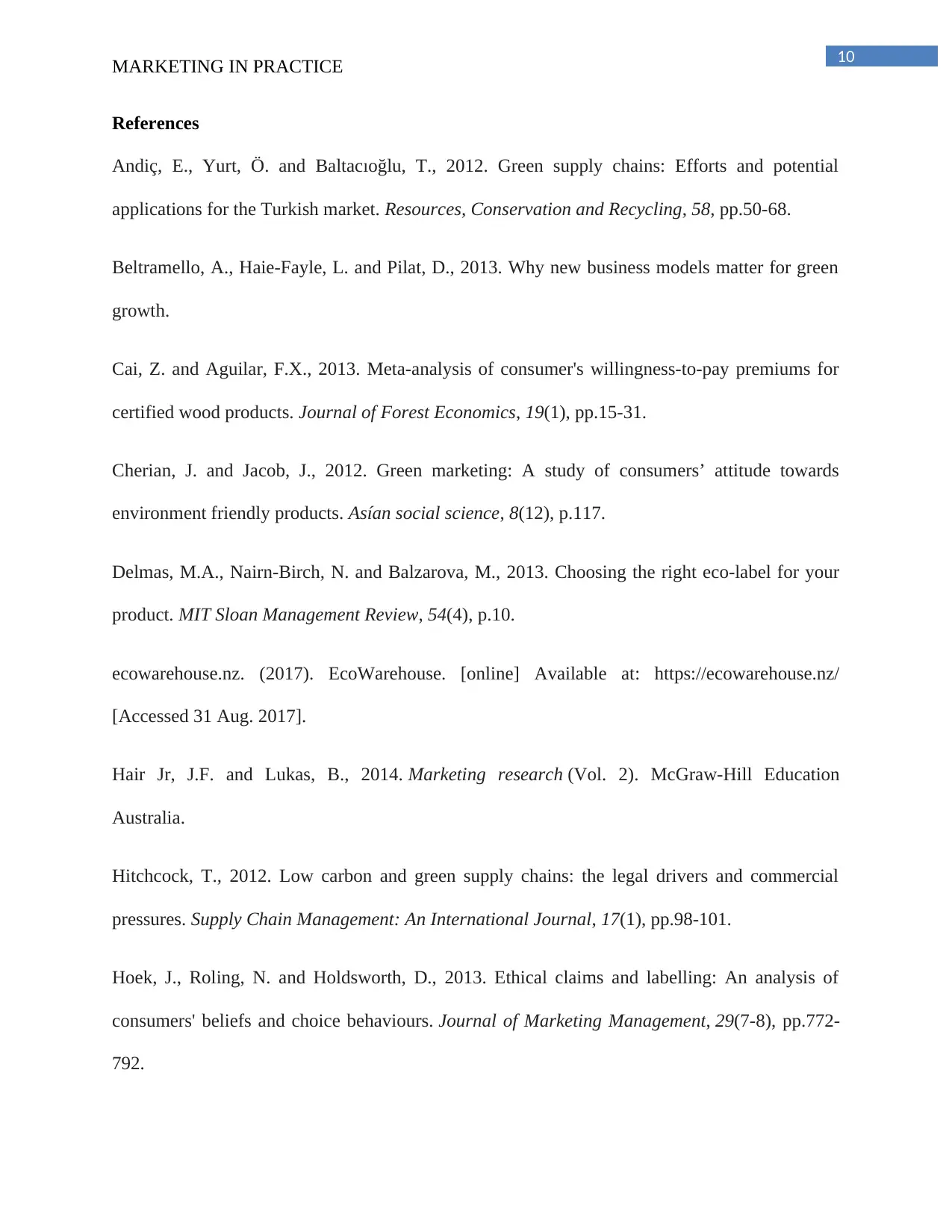
10
MARKETING IN PRACTICE
References
Andiç, E., Yurt, Ö. and Baltacıoğlu, T., 2012. Green supply chains: Efforts and potential
applications for the Turkish market. Resources, Conservation and Recycling, 58, pp.50-68.
Beltramello, A., Haie-Fayle, L. and Pilat, D., 2013. Why new business models matter for green
growth.
Cai, Z. and Aguilar, F.X., 2013. Meta-analysis of consumer's willingness-to-pay premiums for
certified wood products. Journal of Forest Economics, 19(1), pp.15-31.
Cherian, J. and Jacob, J., 2012. Green marketing: A study of consumers’ attitude towards
environment friendly products. Asían social science, 8(12), p.117.
Delmas, M.A., Nairn-Birch, N. and Balzarova, M., 2013. Choosing the right eco-label for your
product. MIT Sloan Management Review, 54(4), p.10.
ecowarehouse.nz. (2017). EcoWarehouse. [online] Available at: https://ecowarehouse.nz/
[Accessed 31 Aug. 2017].
Hair Jr, J.F. and Lukas, B., 2014. Marketing research (Vol. 2). McGraw-Hill Education
Australia.
Hitchcock, T., 2012. Low carbon and green supply chains: the legal drivers and commercial
pressures. Supply Chain Management: An International Journal, 17(1), pp.98-101.
Hoek, J., Roling, N. and Holdsworth, D., 2013. Ethical claims and labelling: An analysis of
consumers' beliefs and choice behaviours. Journal of Marketing Management, 29(7-8), pp.772-
792.
MARKETING IN PRACTICE
References
Andiç, E., Yurt, Ö. and Baltacıoğlu, T., 2012. Green supply chains: Efforts and potential
applications for the Turkish market. Resources, Conservation and Recycling, 58, pp.50-68.
Beltramello, A., Haie-Fayle, L. and Pilat, D., 2013. Why new business models matter for green
growth.
Cai, Z. and Aguilar, F.X., 2013. Meta-analysis of consumer's willingness-to-pay premiums for
certified wood products. Journal of Forest Economics, 19(1), pp.15-31.
Cherian, J. and Jacob, J., 2012. Green marketing: A study of consumers’ attitude towards
environment friendly products. Asían social science, 8(12), p.117.
Delmas, M.A., Nairn-Birch, N. and Balzarova, M., 2013. Choosing the right eco-label for your
product. MIT Sloan Management Review, 54(4), p.10.
ecowarehouse.nz. (2017). EcoWarehouse. [online] Available at: https://ecowarehouse.nz/
[Accessed 31 Aug. 2017].
Hair Jr, J.F. and Lukas, B., 2014. Marketing research (Vol. 2). McGraw-Hill Education
Australia.
Hitchcock, T., 2012. Low carbon and green supply chains: the legal drivers and commercial
pressures. Supply Chain Management: An International Journal, 17(1), pp.98-101.
Hoek, J., Roling, N. and Holdsworth, D., 2013. Ethical claims and labelling: An analysis of
consumers' beliefs and choice behaviours. Journal of Marketing Management, 29(7-8), pp.772-
792.
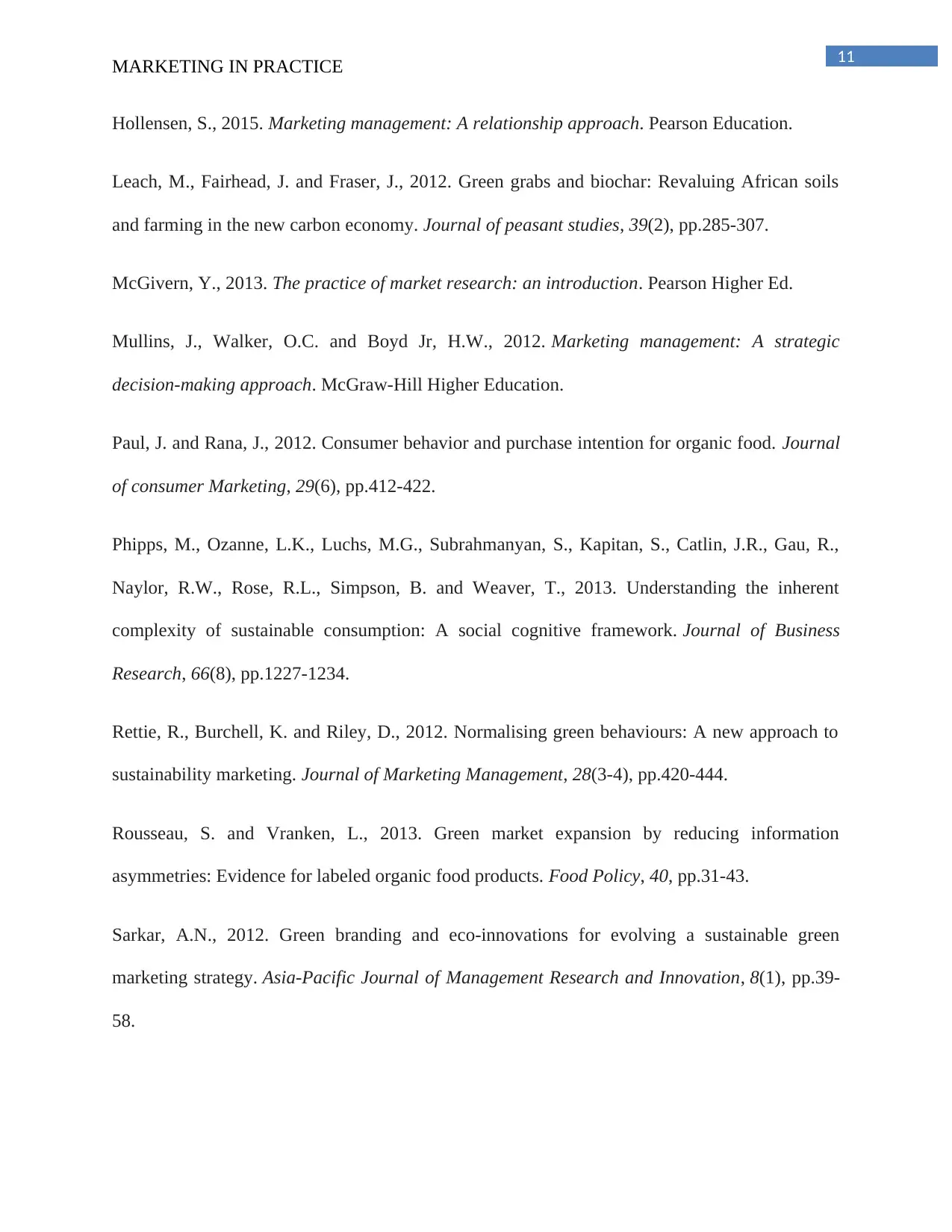
11
MARKETING IN PRACTICE
Hollensen, S., 2015. Marketing management: A relationship approach. Pearson Education.
Leach, M., Fairhead, J. and Fraser, J., 2012. Green grabs and biochar: Revaluing African soils
and farming in the new carbon economy. Journal of peasant studies, 39(2), pp.285-307.
McGivern, Y., 2013. The practice of market research: an introduction. Pearson Higher Ed.
Mullins, J., Walker, O.C. and Boyd Jr, H.W., 2012. Marketing management: A strategic
decision-making approach. McGraw-Hill Higher Education.
Paul, J. and Rana, J., 2012. Consumer behavior and purchase intention for organic food. Journal
of consumer Marketing, 29(6), pp.412-422.
Phipps, M., Ozanne, L.K., Luchs, M.G., Subrahmanyan, S., Kapitan, S., Catlin, J.R., Gau, R.,
Naylor, R.W., Rose, R.L., Simpson, B. and Weaver, T., 2013. Understanding the inherent
complexity of sustainable consumption: A social cognitive framework. Journal of Business
Research, 66(8), pp.1227-1234.
Rettie, R., Burchell, K. and Riley, D., 2012. Normalising green behaviours: A new approach to
sustainability marketing. Journal of Marketing Management, 28(3-4), pp.420-444.
Rousseau, S. and Vranken, L., 2013. Green market expansion by reducing information
asymmetries: Evidence for labeled organic food products. Food Policy, 40, pp.31-43.
Sarkar, A.N., 2012. Green branding and eco-innovations for evolving a sustainable green
marketing strategy. Asia-Pacific Journal of Management Research and Innovation, 8(1), pp.39-
58.
MARKETING IN PRACTICE
Hollensen, S., 2015. Marketing management: A relationship approach. Pearson Education.
Leach, M., Fairhead, J. and Fraser, J., 2012. Green grabs and biochar: Revaluing African soils
and farming in the new carbon economy. Journal of peasant studies, 39(2), pp.285-307.
McGivern, Y., 2013. The practice of market research: an introduction. Pearson Higher Ed.
Mullins, J., Walker, O.C. and Boyd Jr, H.W., 2012. Marketing management: A strategic
decision-making approach. McGraw-Hill Higher Education.
Paul, J. and Rana, J., 2012. Consumer behavior and purchase intention for organic food. Journal
of consumer Marketing, 29(6), pp.412-422.
Phipps, M., Ozanne, L.K., Luchs, M.G., Subrahmanyan, S., Kapitan, S., Catlin, J.R., Gau, R.,
Naylor, R.W., Rose, R.L., Simpson, B. and Weaver, T., 2013. Understanding the inherent
complexity of sustainable consumption: A social cognitive framework. Journal of Business
Research, 66(8), pp.1227-1234.
Rettie, R., Burchell, K. and Riley, D., 2012. Normalising green behaviours: A new approach to
sustainability marketing. Journal of Marketing Management, 28(3-4), pp.420-444.
Rousseau, S. and Vranken, L., 2013. Green market expansion by reducing information
asymmetries: Evidence for labeled organic food products. Food Policy, 40, pp.31-43.
Sarkar, A.N., 2012. Green branding and eco-innovations for evolving a sustainable green
marketing strategy. Asia-Pacific Journal of Management Research and Innovation, 8(1), pp.39-
58.
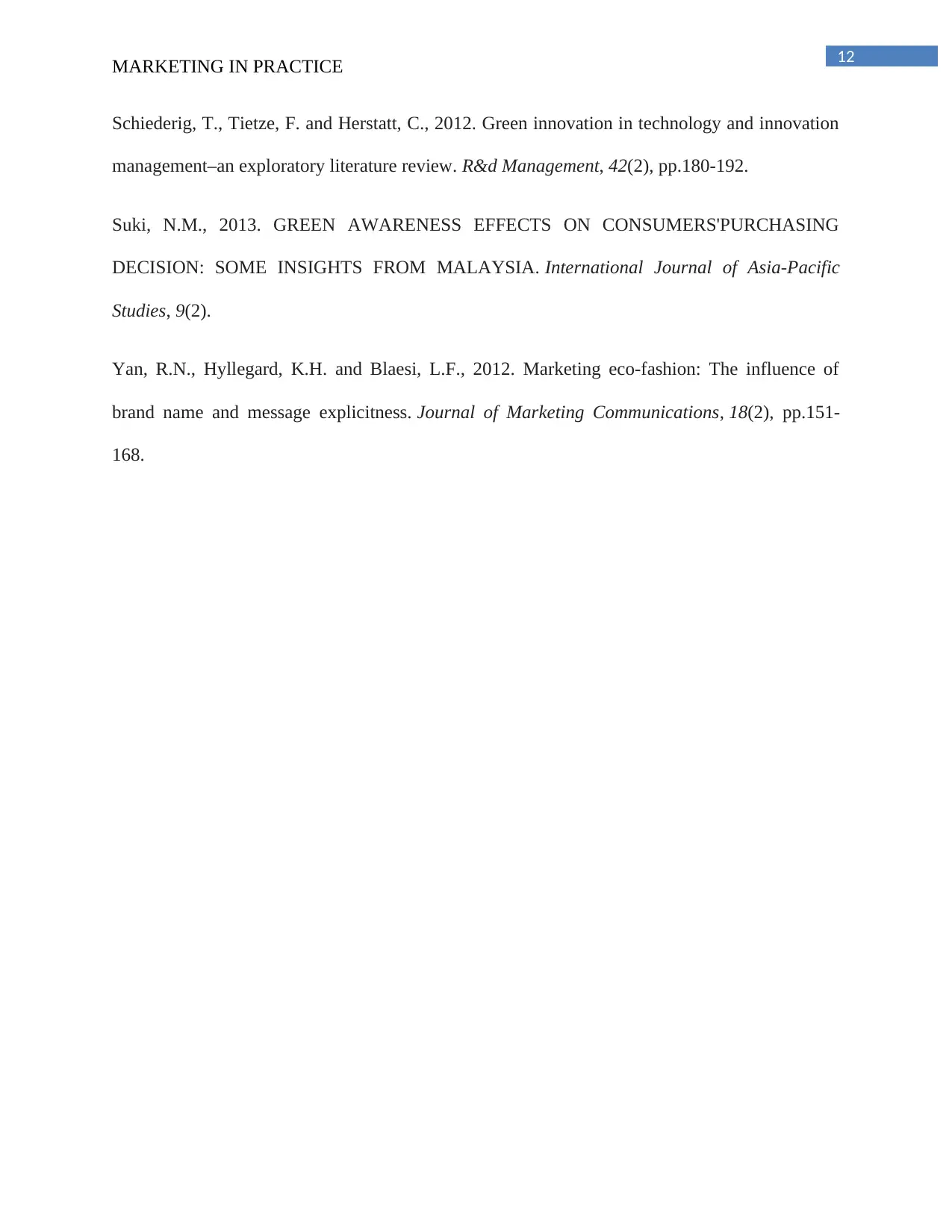
12
MARKETING IN PRACTICE
Schiederig, T., Tietze, F. and Herstatt, C., 2012. Green innovation in technology and innovation
management–an exploratory literature review. R&d Management, 42(2), pp.180-192.
Suki, N.M., 2013. GREEN AWARENESS EFFECTS ON CONSUMERS'PURCHASING
DECISION: SOME INSIGHTS FROM MALAYSIA. International Journal of Asia-Pacific
Studies, 9(2).
Yan, R.N., Hyllegard, K.H. and Blaesi, L.F., 2012. Marketing eco-fashion: The influence of
brand name and message explicitness. Journal of Marketing Communications, 18(2), pp.151-
168.
MARKETING IN PRACTICE
Schiederig, T., Tietze, F. and Herstatt, C., 2012. Green innovation in technology and innovation
management–an exploratory literature review. R&d Management, 42(2), pp.180-192.
Suki, N.M., 2013. GREEN AWARENESS EFFECTS ON CONSUMERS'PURCHASING
DECISION: SOME INSIGHTS FROM MALAYSIA. International Journal of Asia-Pacific
Studies, 9(2).
Yan, R.N., Hyllegard, K.H. and Blaesi, L.F., 2012. Marketing eco-fashion: The influence of
brand name and message explicitness. Journal of Marketing Communications, 18(2), pp.151-
168.
Paraphrase This Document
Need a fresh take? Get an instant paraphrase of this document with our AI Paraphraser
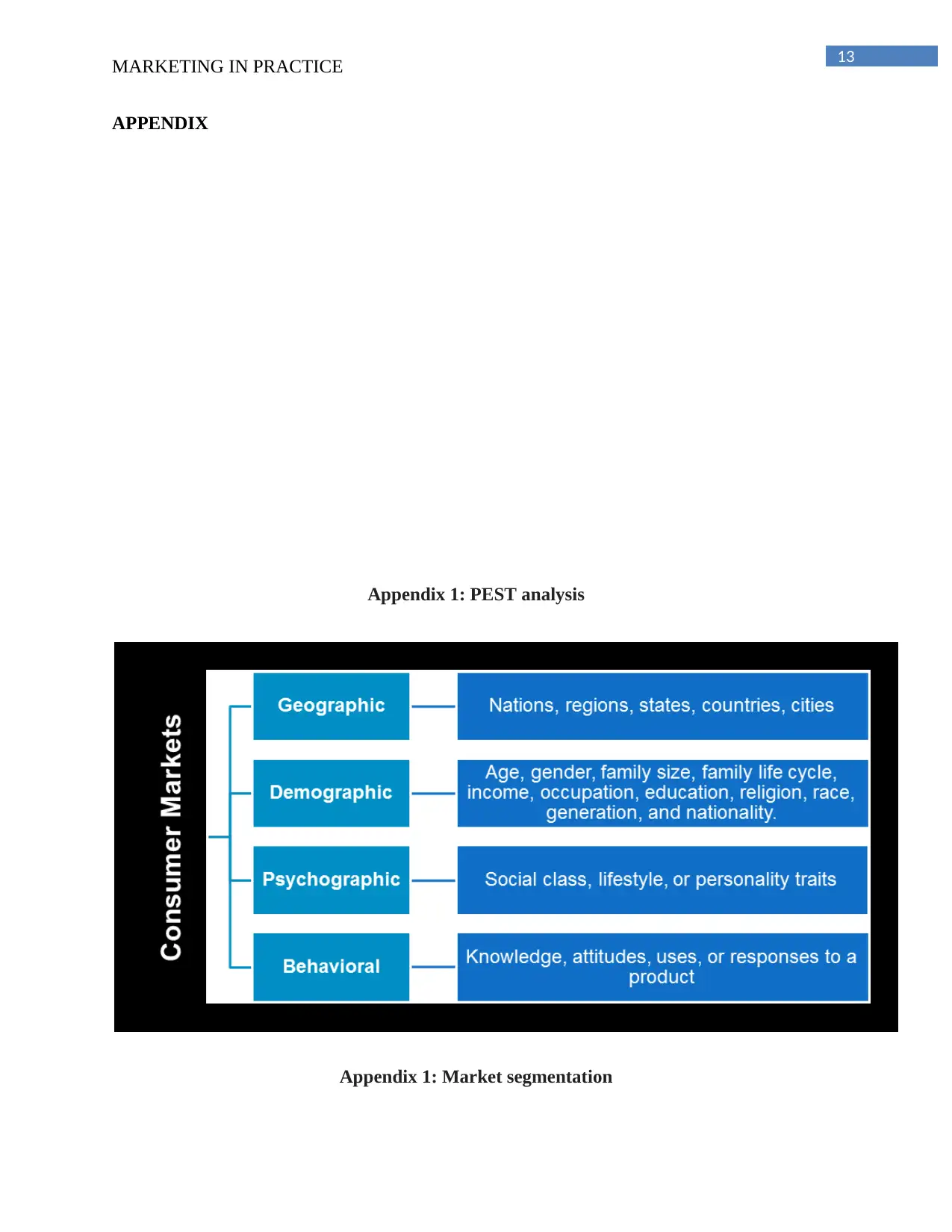
13
MARKETING IN PRACTICE
APPENDIX
Appendix 1: PEST analysis
Appendix 1: Market segmentation
ECONOMICFACTORS1.ThechangeintherateofinflationhasallowedEcoWarehousetosetpricesofproductsdeliveredaccordingly.2.Thepricesoftheproductsarekeptlowersothatitcaninfluencetheconsumerbuyingbehaviours.SOCIALFACTORS1.ThebuyingtrendsofconsumersinNewZealand2.Identificationofdifferentmarketsegmentsandpopulationtoexaminetheneedforecoproductsforthehousehold.TECHNOLOGICALFACTORS1.Mnagaemnetofonlineshoppingwebsitefordleiveringecoproductstohousehold.2.Theautomationprocess,researchanddevelopmenthavealsohelpedincreatingtechnologicalawareness.PESTanalysis
MARKETING IN PRACTICE
APPENDIX
Appendix 1: PEST analysis
Appendix 1: Market segmentation
ECONOMICFACTORS1.ThechangeintherateofinflationhasallowedEcoWarehousetosetpricesofproductsdeliveredaccordingly.2.Thepricesoftheproductsarekeptlowersothatitcaninfluencetheconsumerbuyingbehaviours.SOCIALFACTORS1.ThebuyingtrendsofconsumersinNewZealand2.Identificationofdifferentmarketsegmentsandpopulationtoexaminetheneedforecoproductsforthehousehold.TECHNOLOGICALFACTORS1.Mnagaemnetofonlineshoppingwebsitefordleiveringecoproductstohousehold.2.Theautomationprocess,researchanddevelopmenthavealsohelpedincreatingtechnologicalawareness.PESTanalysis
1 out of 14
Your All-in-One AI-Powered Toolkit for Academic Success.
+13062052269
info@desklib.com
Available 24*7 on WhatsApp / Email
![[object Object]](/_next/static/media/star-bottom.7253800d.svg)
Unlock your academic potential
© 2024 | Zucol Services PVT LTD | All rights reserved.



